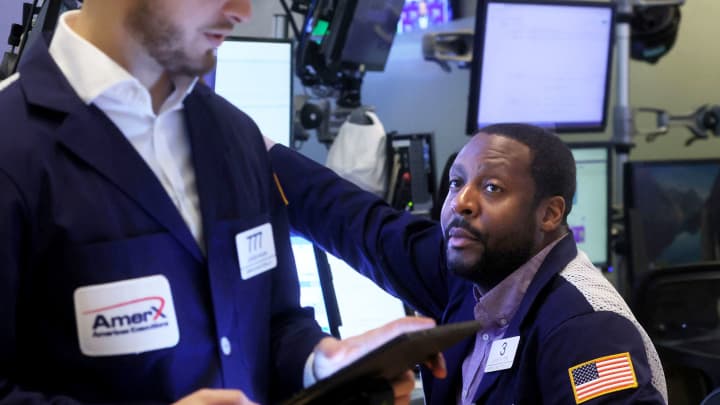
Stock futures rose Friday morning as Wall Street parsed the latest earnings from big-name technology companies and a July jobs report.
linked to the tech-heavy index jumped about 0.5%, while gained 0.4%. tied to the Dow Jones Industrial Average rose 70 points, or 0.2%
showed 187,000 jobs added in July, less than the 200,000 expected by economists polled by Dow Jones. The unemployment rate also ticked lower to 3.5% from 3.6%.
Despite the cooler headline numbers, average hourly wages pointed toward more inflation and came in ahead of expectations, rising 0.4% for the month, and 4.4% on an annualized basis. That came in slightly ahead of the 0.3% and 4.2% expected, respectively.
"Higher for longer is still the base case for interest rates, but if employment numbers continue to cool, it will make it easier for the Fed to shift to a less-hawkish stance," said Mike Loewengart, head of model portfolio construction at Morgan Stanley Global Investment Office. "There are two sides to this coin, though: If the labor market slows too much, recession concerns could gain new traction."
Wall Street also assessed a deluge of earnings reports released after the bell Thursday and premarket Friday. jumped 9% after on profit and , while lost around 2.6% on revenue from the year-ago quarter.
Beyond mega-cap tech, slipped after the company said nights and experiences booked than Wall Street anticipated. popped 12% on the back of a report that exceeded analyst expectations.
So far this season about 79% of S&P 500 companies have given results, with about 80% surpassing Wall Street expectations, according to FactSet.
"The last batch of Q2 earnings this week delivered more beats, resilient margins, stable guidance and showed appetite for capex/capital returns, despite worries about the economy," said Emmanual Cau, head of European equity strategy at Barclays. "Positive EPS momentum has supported the rally, but rates volatility is back in the driver's seat."
A in the yield weighed on stocks in Thursday's session, with the three major indexes
As of Thursday's close, all three major indexes are on pace to end the week lower. The and — down about 2.5% and 1.8%, respectively — are poised to post their worst weekly performances since March. The has slid 0.7% on a week-to-date basis.
The U.S. economy added 187,000 jobs in July, up from 185,000 in June. That market the smallest increase in nonfarm payrolls since December 2020.
The unemployment rate ticked lower to 3.5% from 3.6% in June and showed the second consecutive month decline and lowest level since April, when unemployment hovered at 3.4%.
The labor force participation rate for prime-age workers fell to 83.4% in July after hitting the highest level since May 2002 in June.
— Gina Francolla, Samantha Subin
The mixed July jobs report adds further validation to the Federal Reserve's "wait and see" approach, according to George Mateyo.
"The Fed will view this report as further confirmation that their stance to 'wait and see' is appropriate as they collect and analyze more data prior to their next meeting in September," he said.
— Samantha Subin
Check out the companies making headlines before the bell on Friday:
Read to see which other companies are making moves before the open.
— Pia Singh
Nonfarm payrolls by 187,000 in July, coming in lower than the Dow Jones estimate for 200,000. The unemployment rate fell to 3.5%, against a consensus estimate that the jobless level would remain steady at 3.6%.
Average hourly earnings rose 0.4% in July.
— Hakyung Kim
's stock fell 2% despite posting as the iPhone maker predicted another quarter of declining sales.
The company posted earnings of $1.26 per share, ahead of the $1.19 estimates by analysts polled by Refinitiv. Revenue came in at $81.8 billion, ahead of the $81.69 billion expected, but sales fell year over year.
While the company does not provide official guidance, its chief financial officer said it's expected revenue to decline during the September quarter
Apple also reported iPhone revenues that fell short of the expected $39.91 billion.
— Kif Leswing, Samantha Subin
Shares of popped nearly 9% in the premarket after the e-commerce company reported its since the fourth quarter of 2020 and signaled a return to double-digit revenue growth.
The company reported earnings of 65 cents a share on revenues of $134.4 billion. That came in ahead of the 35 cents and $131.5 billion expected by analysts, according to Refinitiv estimates.
Amazon also issued better-than-expected guidance for the third quarter, saying that it expects sales to range between $138 billion and $143 billion. Analysts polled by Refinitiv were expecting revenue of $138.25 billion.
— Annie Palmer, Samantha Subin
Multiple reports indicated private equity firm KKR is in talks to buy publisher Simon & Schuster from Paramount Global for more than $1 billion. The sale would come after the media giant's sale of Simon & Schuster was blocked by a judge.
Paramount shares rose 2% in the premarket. The company declined to comment on the reports.
— Fred Imbert
Morgan Stanley's Mike Wilson warned that, while investors have been cheering data showing easing inflation, disinflationary pressures are now turning into a headwind for the market.
"Falling inflation will cause a downside surprise on top-line revenues as pricing power is diminished, especially for the goods economy," wrote Wilson, the bank's chief U.S. equity strategist.
— Fred Imbert, Michael Bloom
held steady on Friday as investors awaited key labor market data that will give fresh insights into the state of the economy and could affect the Federal Reserve's next policy moves.
At 4:08 a.m. ET, the yield on the was down by less than one basis point to 4.1797% as it continued to hover near levels last seen in November 2022, which it had jumped to earlier in the week. The was up by over one basis point to 4.9127%.
— Sophie Kiderlin
European markets opened slightly higher to close off a downbeat week, as investors digest the Thursday and more company earnings.
The pan-European Stoxx 600 index was up 0.2% in the first few minutes of trading, with sectors spread across positive and negative territory. Banking stocks led minor gains, up 0.6%, while media stocks dropped 0.4%.
— Hannah Ward-Glenton
China announced on Friday it will lift tariffs on Australian barley imports starting Aug. 5, a move that points to and would alleviate supply concerns after Russia to deliver key Ukrainian grains to global markets.
The Chinese Ministry of Commerce "has ruled that it is no longer necessary to continue to impose anti-dumping duties and countervailing duties on imports of barley originating in Australia in view of changes in the Chinese barley market," it Friday. No further details on these changes were provided.
Australia's trade, foreign and agriculture ministers said they " " and expect a similar process to follow for the removal of duties on Australian wine. In March 2021, of up to 218% on Australian wine.
For more, please read .
— Clement Tan
Australia's central bank has cut the growth outlook for the country to 1% for 2023, down from its previous estimate of 1.25%.
The Reserve Bank of Australia said in its quarterly that "growth in economic activity in Australia is forecast to remain subdued over the rest of the year, as cost-of-living pressures and the rise in interest rates continue to weigh on domestic demand."
Still, the RBA noted inflation was "heading in the right direction," cutting its inflation rate forecasts to 4.25% from 4.5%. The bank noted that inflation has been declining in the June quarter, but says it still remains "too high."
It expects inflation to continue to decline, hitting 3.75% at the end of 2024 and back within the 2–3% target range in late 2025.
— Lim Hui Jie
Hong Kong's led gains in Asia on Friday, powered mainly by property and basic materials stocks.
The index climbed 1.61%, with top gainers on the HSI being property stocks like Longfor Group, which saw a 6.88% rise in its shares.
This was followed by Country Garden Holdings, which rose 4.14% and China Resources Land, which climbed 3.84%.
— Lim Hui Jie
It's been a hot summer for the , but the small-cap index remains short of eclipsing its 52-week high.
Over the past three months, the index has gained 12.7% – outperforming the and the in that period. All three of the major averages have notched fresh 52-week highs over the summer, with the 30-stock Dow registering this achievement earlier this week.
The Russell 2000 is about 3.5% away from its 52-week high level of 2,030.05, which it hit on Aug. 16, 2022.
- Darla Mercado, Gina Francolla
Bullishness among individual investors that stocks prices will rise over the next six months surged again, to 49.0% from 44.9% last week, and stayed above the historic average of 37.5% for a ninth straight week, according to the latest survey from the
The last time bullishness was above average for this long was from February-May, 2021.
That's good for contrarians who want to bet against the market. Rising bullishness is usually tied to increased risk, and can suggest that much of the desired buying has already happened.
Bearish sentiment, that prices will drop in the next six months, fell to 21.3% among retail investors, from 24.1% last week, and was below average (31.0%) for a ninth week — the longest since February-June, 2021.
Neutral sentiment, that prices won't change much over the next six months, eased to 29.7% from 31.0% against an historical average of 31.5%.
— Scott Schnipper
With just Friday's session left in the trading week, the three major indexes are on pace for losses.
The and have lost 2.5% and 1.8%, respectively, since the week began. Both are on track to post their worst weekly performances since March.
The , meanwhile, has slid 0.7% on a week-to-date basis.
— Alex Harring
Warren Buffett's Berkshire Hathaway finished Thursday's session at a record high on a closing basis. climbed 1.4% to close at an all-time high of $541,000, exceeding the conglomerate's previous record of $539,180 reached on March 22, 2022.
The Omaha-based conglomerate reports second-quarter earnings this Saturday. The stock has gained more than 15% this year.
— Yun Li
These are some of the stocks making the biggest after-hour moves:
— Alex Harring
Stock futures were only modestly off flat shortly after 6 p.m. ET.
Futures tied to the Dow, S&P 500 and Nasdaq 100 were all little changed, within 0.1% of their flatlines.
— Alex Harring




